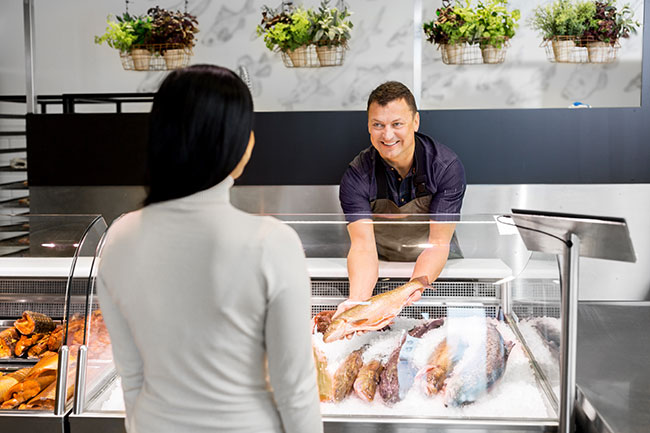
News
Opinion
Education
Management
Sustainability
Getting consumer buy-in for aquaculture
April 28, 2020 By Maddi Badiola
 Locally produced seafood is gaining traction in supermarket shelves. (Photo: AdobeStock)
Locally produced seafood is gaining traction in supermarket shelves. (Photo: AdobeStock) I recently joined a roundtable discussion called, “Come Together: Uniting the Farmed and Wild Seafood Sectors,” organized by the Global Aquaculture Alliance (GAA). The GAA is an international non-governmental organization dedicated to advocacy, education and leadership in responsible aquaculture. The main objetive of the discussion was to look for the best way to collaborate as an industry to get people to eat more seafood. And this is where I am focused.
Continuing with my last article, we understand the importance of people’s opinion. Public concern towards aquaculture practices is apparent but the need to make people aware of the need and benefit of seafood consumption is clear.
Customers are the main target
Where I come from, in Basque Country in Northern Spain, seafood consumption is one of the highest in the entire world. Because it is one of the most important industries in the region, people are proud advocates for serving wild seafood. You will often hear promos that say, “Here, we only have wild, fresh and tasty. Aquaculture products are not served here,” or “Aquaculture is not the same as wild!”
Customers will prefer to be served wild even though studies have shown again and again that they are rarely able to differentiate which fish is farmed or not. At the same time, people will agree that oceans carry toxic compounds that directly impact fauna in the region. But do they truly understand that these “wild, fresh fish” could carry harmful metals and plastics? Are these fish 100 percent traceable? The doubts are real and the discussion should be open and extensive.
Aquaculture professionals have to play a role in these discussions. And it has to go beyond the existing rivalry between wild and farmed. Wild and farmed fish share the supermarket shelves. They are fish anyway you look at it. The fisheries and aquaculture industries should be working together in order to satisfy the needs and development of both. Aquaculture products are filling the gap that the fisheries can no longer provide, so they are not competitors, not antagonistics. They are equal protagonists of this new blue era.
Certification programs
As customers, we like certifications. We feel more comfortable buying a certified fish, which is why more and more programs are out there. The GAA, for example, through the development of their Best Aquaculture Practices (BAP) certification standards has become a leading standards-setting organization for aquaculture seafood.
Another program, very well known in the U.S. is the Seafood Watch program (Monterey Bay Aquarium). Their recommendations help consumers choose seafood that is fished or farmed in ways that have less impact on the environment. They even offer pocket-sized guides and an app with the latest recommendations.
Another trendy program is the one offered by the Aquaculture Stewardship Council (ASC), which certifies environmentally and socially responsible seafood. Together with scientists, conservation groups, NGOs, aquaculture producers, seafood processors, retail and food service companies and consumers, ASC encourages responsible aquaculture in order to transform the world’s seafood markets and to promote the best environmental and social aquaculture performance.
The Food and Agriculture Organization (FAO) recognizes at least 30 certification programs and eight key international agreements relevant to aquaculture certification. There are also nine initiatives identified addressing sustainability issues and creating a framework for differentiating sources of aquatic products in this respect.
Tagging is trending
Circular economy, sustainability, efficiency, eco-designing – these are popular tags we use for our business, believing that this would make us successful. I admit that the language is important but there is more to this.
The daily basic actions are the ones that define ourselves and our businesses. The companies and employees who believe in this industry should go beyond the office walls and talk more about fish. Who has not ended up queuing or waiting to be served in the supermarket and talked about how the fish looks, where they come from and what they eat? I do this every time I can.
I do it on purpose, with a purpose. I ask about the origin, farmed or not. You can create a conversation where you can discuss and know more about consumer opinion. And that is what we need to know – what they think about the aquaculture industry, what their concerns are and how we can improve to make them feel comfortable purchasing farmed seafood.
Certification is needed, traceability is a must, but we also need to talk more with consumers in the place where they buy the fish. Supermarkets, restaurants, festivals and food-trucks are the places where we need to be. Customers will begin to feel confidence if we speak in an informal language, face to face, without technical or complicated terms.
Maddi Badiola, PhD, is a RAS engineer and co-founder of HTH aquaMetrics llc, (www.HTHaqua.com) based in Getxo, Basque Country, Spain. Her specialty is energy conservation, lifecycle assessments and RAS global sustainability assessments. Email her at mbadiolamillate@gmail.com or contatct her through LinkedIn, Facebook and Instagram.
Print this page